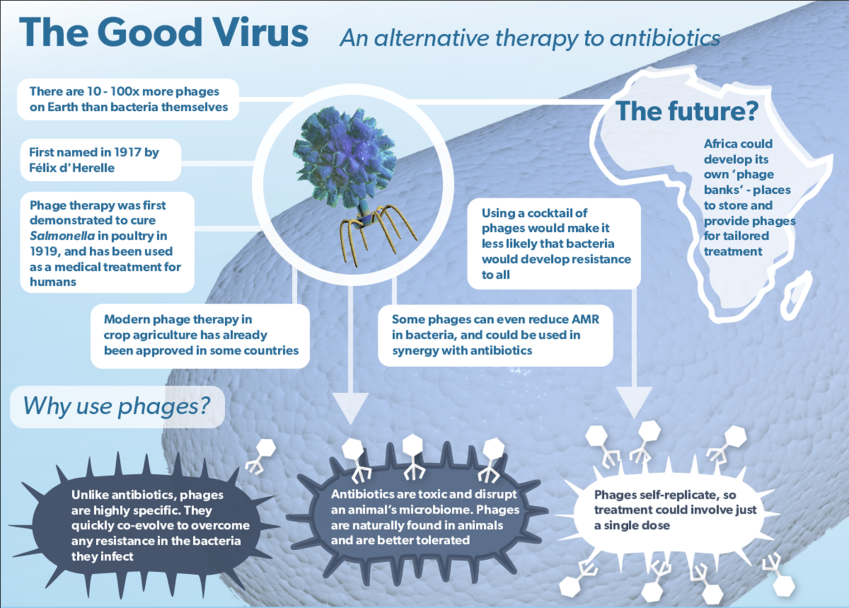Description

Copyright infringement not intended
Context: Scientists are exploring the potential of bacteriophages to cure infections caused by bacteria that are resistant to antibiotics.
Details
- Bacteriophages are viruses that infect and destroy specific bacteria. They are found in nature and have been used as alternative treatments for bacterial infections in some countries. However, bacteriophages are not widely accepted or regulated in most parts of the world. This may change as antibiotic resistance becomes a global health threat.
- Scientists are exploring the potential of bacteriophages to cure infections caused by bacteria that are resistant to antibiotics. They have several advantages over antibiotics, such as specificity, adaptability, and safety. However, they also face some challenges, such as delivery, stability, and immune response.
- More research and clinical trials are needed to evaluate the efficacy and safety of bacteriophages as novel therapy for bacterial infections.

Bacteriophages
About
- Bacteriophages, or phages, are viruses that exclusively infect and replicate within bacterial cells. They were first discovered in the early 20th century by British bacteriologist Frederick Twort and French-Canadian microbiologist Félix d'Hérelle.
- D'Hérelle, in particular, recognized their potential in combatting bacterial infections, and he is often credited with coining the term "bacteriophage," meaning "bacteria-eater."
- Bacteriophages are found abundantly in various environments, such as soil, water, and the human body, wherever bacteria exist. They have been extensively studied for their specificity, structure, and potential applications in medicine, biotechnology, and food safety.

Features
- Specificity: Each Bacteriophages species has a narrow host range and can only infect specific types of bacteria. This specificity is attributed to the recognition and binding of phage proteins to receptors on the bacterial cell surface.
- Structure: Bacteriophages typically consist of genetic material, which can be either DNA or RNA, encased in a protein coat. Some Bacteriophages also have additional structures, such as tail fibres or spikes, which they use to attach to and inject their genetic material into the bacterial cell.
- Replication: Once Bacteriophages infects a susceptible bacterium, it takes over the bacterial machinery to replicate its genetic material and assemble new phage particles. Eventually, the bacterial cell lyses, releasing multiple new Bacteriophages that can infect other bacteria nearby.
- Abundance: Bacteriophages are the most abundant entities on Earth, estimated to outnumber bacteria by at least 10 to 1. They play a crucial role in regulating bacterial populations in various ecosystems.
Impact and Significances:
Potential Antibacterial Therapy
- Bacteriophages offer a targeted and specific approach to combat bacterial infections. They can be used as an alternative or complementary therapy to antibiotics, helping to reduce the emergence of antibiotic-resistant bacteria.
- They have several advantages over antibiotics, such as their ability to self-replicate, evolve, and lyse bacterial cells. They have fewer side effects, as they do not affect the normal flora of the host. However, Bacteriophages also face some challenges, such as their narrow host range, immune clearance, and bacterial resistance.
Precision Medicine
- Bacteriophages can be customized to target specific bacterial strains, allowing for personalized treatments based on the infecting pathogen. This precision helps to minimize collateral damage to beneficial bacteria in the body. For example, phage therapy can be tailored to treat urinary tract infections caused by Escherichia coli, without harming the lactobacilli that protect the vaginal microbiome.
- The therapy can also be combined with other modalities, such as antibiotics, probiotics, or immunotherapy, to enhance its efficacy and safety.
Food Safety
- Bacteriophages can be employed in food production and processing to control and eliminate harmful bacteria, enhancing food safety and reducing the risk of foodborne illnesses.
- They can be applied to various food products, such as meat, dairy, fruits, vegetables, and beverages, to prevent or treat bacterial contamination.
- They can also be used as biosensors to detect the presence of pathogens in food samples. They have several benefits over chemical preservatives, such as their specificity, stability, and biodegradability.
Environmental Applications
- Bacteriophages have potential environmental applications, such as bioremediation, where they can target and eliminate specific bacteria in polluted environments. For instance, Bacteriophages can be used to degrade petroleum hydrocarbons in oil spills or to remove heavy metals from wastewater.
- Bacteriophages can be used to control bacterial populations in aquaculture, agriculture, and animal husbandry, improving the health and productivity of these sectors.
Biotechnological Tools
- Bacteriophages are valuable tools in biotechnology, facilitating bacterial detection, genetic engineering, and phage display techniques for various research and industrial applications. For example, Bacteriophages can be used to deliver genes or proteins into bacterial cells for genetic modification or expression.
- They can be used to display peptides or antibodies on their surface for screening or selection purposes. They have enabled the discovery and development of many novel therapeutics, diagnostics, and vaccines.
Challenges
- Bacteriophages Selection: Identifying the most effective Bacteriophages for specific bacterial infections requires extensive research and screening, as not all Bacteriophages are equally potent against all bacterial strains.
- Regulatory Approval: The regulatory pathway for the therapy is complex and varies across different countries. The lack of standardized regulations can hinder the widespread use of Bacteriophages therapy.
- Bacterial Resistance: Similar to antibiotics, bacteria can develop resistance to Bacteriophages, potentially limiting their long-term effectiveness. Understanding and managing resistance mechanisms are critical to ensuring phage therapies remain potent.
- Bacteriophages Delivery: Efficient delivery of Bacteriophages to the site of infection can be challenging, particularly for internal infections. The development of delivery systems is necessary to ensure Bacteriophages reach their target.

Bacteriophages and Antibiotics Which one is better?
- Bacteriophages and antibiotics are both used to combat bacterial infections, but they work in different ways and have distinct advantages and disadvantages.
|
|
Bacteriophages
|
Antibiotics
|
|
Mechanism of Action
|
- Bacteriophages are viruses that infect and replicate within bacterial cells.
- They specifically target and kill the bacteria they infect by hijacking the bacterial machinery to produce more Bacteriophages, eventually causing the bacterial cell to burst and release new Bacteriophages.
|
- Antibiotics are chemical substances produced by microorganisms or synthesized in the laboratory.
- They target bacteria by interfering with their cellular processes, such as inhibiting cell wall synthesis, protein synthesis, or DNA replication. This leads to the death or inhibition of bacterial growth.
|
|
Specificity
|
- Bacteriophages are highly specific to certain bacterial strains or species. Each Bacteriophages has a narrow host range and will only infect a limited number of bacterial types.
|
- Antibiotics can have a broad or narrow spectrum of activity. Some antibiotics are effective against a wide range of bacteria (broad-spectrum), while others target specific types of bacteria (narrow-spectrum).
|
|
Antibiotic Resistance
|
- Bacterial resistance to Bacteriophages can develop, but it is generally less common than antibiotic resistance.
- Bacteriophages can evolve rapidly to overcome bacterial defences, making it challenging for bacteria to develop widespread resistance.
|
- ntibiotic resistance is a significant concern. Overuse and misuse of antibiotics have led to the emergence of drug-resistant bacteria, making some infections difficult or even impossible to treat with conventional antibiotics.
|
|
Impact on the Microbiome
|
- Bacteriophages are highly specific, so they generally do not harm beneficial bacteria in the body. They have minimal impact on the normal microbiome.
|
- Antibiotics can disrupt the balance of the microbiome, leading to imbalances in gut flora and increasing the risk of opportunistic infections, such as Clostridium difficile infection.
|
|
Adaptability
|
- Bacteriophages can adapt quickly to changes in bacterial populations, making them potentially useful against evolving bacterial strains.
|
- Antibiotics have limited adaptability. Once bacterial resistance develops, the antibiotic becomes less effective against the resistant strains.
|
Both bacteriophages and antibiotics have their strengths and weaknesses. Bacteriophages show promise as a targeted and precise approach to combat bacterial infections, particularly in the context of antibiotic resistance. However, antibiotics remain crucial for many infections and are still widely used as the first-line treatment. The future of infectious disease management may involve a combination of both approaches to tackle the challenges posed by bacterial infections and resistance.
To harness the potential of bacteriophages effectively, the following steps can be taken:
Research and Development
- Continued research into Bacteriophages biology, genomics, and interactions with bacteria will lead to the discovery of novel bacteriophages and enhance our understanding of their therapeutic potential. This will help us design more effective and specific phage cocktails, engineer phages with improved properties, and identify new targets for phage therapy.
Clinical Trials
- Rigorous clinical trials are essential to establish the safety and efficacy of Bacteriophage therapies for different bacterial infections. This will provide evidence-based data on the optimal dose, route, frequency, and duration of Bacteriophage administration, as well as the possible side effects, interactions, and contraindications of Bacteriophage therapy.
Bacteriophage Libraries
- Building comprehensive libraries of characterized bacteriophages can facilitate the rapid identification of suitable bacteriophages for treatment. This will enable us to match the phages to the bacterial strains causing the infection and to monitor the emergence and spread of Bacteriophages-resistant bacteria.
Combination Therapies
- Investigate combination therapies involving bacteriophages and antibiotics to enhance treatment outcomes and mitigate the risk of resistance. This will allow us to exploit the synergistic effects of Bacteriophages and antibiotics, reduce the dose and toxicity of antibiotics, and prevent or delay the development of resistance in bacteria.
Education and Awareness
- Public and medical professional education on the benefits, safety, and proper use of Bacteriophage therapy can increase its acceptance and adoption. This will help us overcome the misconceptions, myths, and fears associated with Bacteriophages, and promote their recognition as a valuable tool for combating bacterial infections.
Regulatory Framework
- Developing standardized regulatory frameworks for Bacteriophage therapy will provide clear guidelines for its clinical use. This will ensure the quality, safety, and efficacy of Bacteriophage products, facilitate their approval and registration, and harmonize their regulation across different countries and regions.
Conclusion
- Bacteriophages hold tremendous potential as a targeted and precise approach to combat bacterial infections, and with continued research, clinical development, and strategic approaches, they could become a valuable weapon in our fight against antibiotic-resistant bacteria and infectious diseases.
Must-Read Articles:
ANTIBIOTICS RESISTANCE: https://www.iasgyan.in/daily-current-affairs/antibiotics-resistance
|
PRACTICE QUESTION
Q. Which of the following statements about bacteriophages and antibiotic resistance is true?
1. Bacteriophages are more likely to induce antibiotic resistance in bacteria.
2. Antibiotics are more effective in treating antibiotic-resistant bacterial infections than bacteriophages.
3. Bacteriophages have a lower likelihood of inducing resistance compared to antibiotics.
4. Bacteriophages and antibiotics have equal potential to induce resistance in bacteria.
How many of the above statements is/are correct?
A) Only 1
B) Only 2
C) Only 3
D) All
Explanation: A
Explanation: Bacteriophages have a lower likelihood of inducing resistance compared to antibiotics. Bacteriophages can rapidly evolve to overcome bacterial defences, making it challenging for bacteria to develop widespread resistance, unlike antibiotics. Only statement 3 is correct.
|
https://indianexpress.com/article/explained/explained-sci-tech/bacteriophages-good-viruses-fight-bacteria-8848914/
















